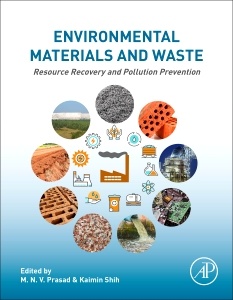Environmental Materials and Waste Resource Recovery and Pollution Prevention
Coordonnateurs : Vara Prasad Majeti Narasimha, Shih Kaimin

Environmental Materials and Waste: Resource Recovery and Pollution Prevention contains the latest information on environmental sustainability as a wide variety of natural resources are increasingly being exploited to meet the demands of a worldwide growing population and economy.
These raw materials cannot, or can only partially, be substituted by renewable resources within the next few decades. As such, the efficient recovery and processing of mineral and energy resources, as well as recycling such resources, is now of significant importance.
The book takes a multidisciplinary approach to fully realize the number of by-products which can be remanufactured, providing the foundation needed across disciplines to tackle this issue. As awareness and opportunities to recover valuable resources from process and bleed streams is gaining interest, sustainable recovery of environmental materials, including wastewater, offers tremendous opportunity to combine profitable and sustainable production.
Chapter 1: Recovery of resources from biowaste for pollution prevention
Chapter 2: Destination of vinasse, a residue from alcohol industry – resource recovery and prevention of pollution
Chapter 3: Biosolids enhances mine site rehabilitation and revegitation
Chapter 4: Application of biochar produced from biowaste materials for environmental protection and sustainable agriculture production
Chapter 5: Production and utilization of biochar from organic wastes for pollutant control on contaminated sites
Chapter 6: Municipal solid waste biochar for prevention of pollution from landfill leachate
Chapter 7: Removal and recovery of metals by biosorbents and biochars derived from biowastes
Chapter 8: Biodiesel production from wastewater using oleaginous yeast and microalga
Chapter 9: Utilization of sludge as manure
Chapter 10: Energy & resource recovery from sludge: Full scale experiences
Chapter 11: Chromite
Chapter 12: Detoxification and resource recovery of chromium-containing wastes
Chapter 13: Asbestos: resource recovery and its waste management
Chapter 14: Resource potential of natural and synthetic gypsum waste
Chapter 15: Metalliferous waste in India and knowledge explosion in metal recovery techniques and processes for prevention of pollution
Chapter 16: Resources recovery from wastewater based on extracellular electron transfer
Chapter 17: Acid Mine Drainages from Abandoned Mines: Hydrochemistry, Environmental Impact, Resource Recovery and Prevention of Pollution
Chapter 18: Restoration of Smelter Industrial Barrens through Pollution Reduction Drives Economic Recovery
Chapter 19: Methods for utilization of red mud and its management
Chapter 20: Thermal behavior of red mud and its beneficial use in glass-ceramic production
Chapter 21: Clay minerals: Structure, chemistry, and significance in contaminated environments and geological CO2 sequestration
Chapter 22: Zeolite for nutrient stripping from farm effluents
Chapter 23: Natural and surfactant modified zeolite for the removal of pollutants (inorganic mainly) from natural waters and wastewaters
Chapter 24: Treatment and reuse of incineration bottom ashes
Chapter 25: Coal fly ash utilization for boron management in soils, plants, and waters
Chapter 26: The crystallization of struvite and its analog (K-struvite) from waste streams for nutrient recycling
Chapter 27: Phosphorus recovery from wastes
Majeti Narasimha Vara Prasad is Emeritus Professor in the School of Life Sciences at the
University of Hyderabad in India. He received his PhD in Botany from Lucknow University,
Lucknow. In past he worked as Lecturer at North Eastern Hill University, Lecturer & Reader at University of Hyderabad. He is also serving as reviewer in many scientific journals. He is professional member of National Institute of Ecology New Delhi, India, Bioenergy Society of India, New Delhi, Indian Network for Soil Contamination Research, New Delhi. He also completed 20 research projects. He has published 179 articles in peer review journals in which contributed as author/co-author. He supervised 17 PhD and 7 M.Phil students, all students received award in his supervision.Kaimin Shih is currently serving as an Executive Editor (Co-Editor-in-Chief) in Journal of Environmental Chemical Engineering (Elsevier), and Associate Editors in Waste Management (Elsevier), Sustainable Environment Research (Springer), and Cleaner Materials (Elsevier). Former Editor in The HKIE Transactions and Associate Editor in American Mineralogist (Mineralogical Society of America). He is currently leading an “Environmental Materials research group working on metal oxides surface reactions, organic pollutant degradation, novel membrane and catalysts for air/wastewater treatments, fate and transport of emerging pollutants, water and resource recoveries, and metal oxide structural designs for environmental and energy applications.
- Presents a state-of-the-art guide to environmental sustainability
- Provides an overview of the field highlighting recent and emerging issues in environmental resource recovery that cover a wide array of by-products for remanufacture potential
- Details a multidisciplinary approach to fully realize the number of by-products which can be remanufactured, providing the foundation needed across disciplines to tackle these global issues
Date de parution : 06-2016
Ouvrage de 750 p.
19x23.3 cm



